提高认知才能开阔眼界
认人待物,不断学习,提高商业和经济方敏锐的洞察力1. Alabama // Bacon Level
While it may sound like some higher plane of breakfast meat existence, Bacon Level, Alabama, is a tiny town that’s been around since the pioneer days. It reportedly got its name when a couple of travelers were robbed of their supplies, including their meaty provisions. They were apparently told that some local outlaws were known to be staying in an area where the trail leveled out. They checked it out and, sure enough, there was their breakfast. And that’s how we got Bacon Level.
2. Alaska // Unalaska
Don’t let the name fool you; Unalaska is as Alaskan as it comes. With a little more than 4500 residents, Unalaska is the largest city in the Aleutian Islands. Originally, Unangan residents named it Agunalaksh, a word that means “near the peninsula.” As Russian fur traders arrived, the spelling morphed into Ounalashka, which eventually became Unalaska. It probably references that it’s near Alaska rather than not Alaska.
3. Arizona // Why
Why call a town Why? This teeny-tiny community near the U.S.-Mexico border is named after the y-shaped intersection of two nearby highways. But the story goes that because of an Arizona law requiring place names have at least three letters, y became the much more existential Why.
4. Arkansas // Smackover
Smackover, Arkansas, was originally settled by French trappers, and it’s believed that the town earned its semi-violent sounding moniker as a result of the French name for the local creek, Chemin Couvert. But some pose other possible origins, like the name sticking after someone marveled about how a settler had jumped “smack over” the local creek.
5. California // Rough and Ready
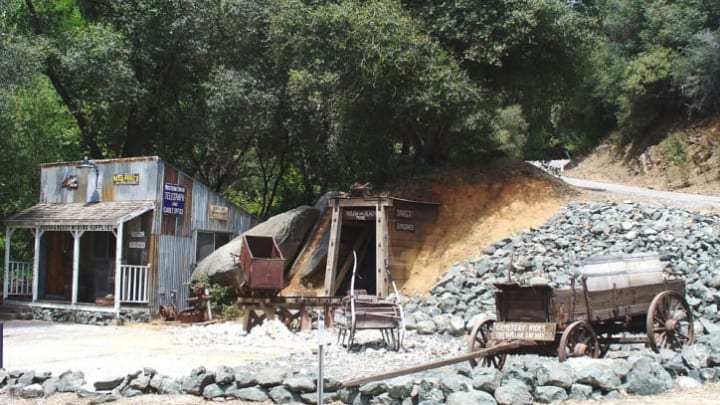
Rough and Ready, California. / Isaac Crumm, Wikimedia Commons // Public Domain
Rough and Ready, California, may have been named for a local mining company, but it also may have been a self-fulfilling prophecy. The town’s earliest residents were known to stand up for their beliefs, and, because they were unhappy about taxation, they seceded from the Union and became their own “republic” in 1850.
6. Colorado // No Name
While there are all sorts of explanations for why this Colorado community went with No Name, the real answer is probably that it’s near No Name Creek and No Name Canyon. Most people speculate that those names came from some surveyor or mapmaker who wasn’t feeling creative that day. Some theorize that there’s a connection to geologist and explorer John Wesley Powell’s boat, which was called “No Name,” but there doesn’t seem to be much evidence for that claim.
7. Connecticut // Hazardville
While Hazardville, Connecticut, was well known as a production hotspot for gunpowder, the name came about in a much less hazardous way: It was named after Colonel Augustus George Hazard, who purchased and expanded the company in 1837.
8. Delaware // Corner Ketch
It’s rumored that Corner Ketch—an unincorporated community in New Castle County, Delaware—got its name from a rough-and-tumble local bar, whose patrons were so quarrelsome that townspeople would warn strangers, “They’ll ketch ye at the corner.”
9. Florida // Two Egg
Two Egg, Florida, supposedly got its name during the Great Depression when two enterprising youngsters in need of sugar traded with a shopkeeper for two eggs.
10. Georgia // Climax
Founded in the 1880s, the tiny town of Climax, Georgia, got its name from its location: It sits at the highest point on the railroad between Savannah and the Chattahoochee River.
11. Hawaii // Volcano
A cozy little burg near Hilo, Volcano is adjacent to several volcano hot spots. (Sorry.) You can walk the dormant Kilauea Iki Trail, the site of a 1959 eruption, and then stop by the Lava Rock Café for a coffee before heading to Hawaii Volcanoes National Park.
12. Idaho // Dickshooter
It might barely qualify as a settlement, but officially, Dickshooter, Idaho, is classified as a populated place, so we’re using it. The best guess as to how this place got its moniker seems to be that there was once a guy living in the area named Dick Shooter.
13. Illinois // Sandwich
No, it’s not named after the cold-cut concoction. Originally called “Almon” after land developer Almon Cage when it was founded in 1855, Sandwich got its name when a prominent politician worked to get a train stop in the area, and it got rechristened “Sandwich” after his hometown of Sandwich, New Hampshire.
14. Indiana // Santa Claus
Santa Claus, Indiana. / Doug Kerr, Flickr // CC BY-SA 2.0
If you’ve ever wondered where your childhood letters to Old Saint Nick ended up, the answer might lie in Indiana. Santa Claus, Indiana, is a festive town in the Hoosier State—but the origin of the name wasn’t quite so festive. As the story goes, the town was first named Santa Fe (or Santa Fee). In 1896, when the town wanted to secure a post office, postal officials told it to pick another name since Santa Fe was already taken. Someone thought Santa Claus was an acceptable alternative, and the post office agreed.
15. Iowa // What Cheer
What Cheer, Iowa, was founded over 150 years ago by a settler named Peter Britton who named the town Petersburg. But in the 1860s, Joseph Andrews had the idea to change the name to What Cheer after an English greeting, and the rest is history.
16. Kansas // Gas
Gas, Kansas, got its name when natural gas was discovered in the area in 1898—but they’ve also made sure to have a little fun with the appellation. The town’s motto? “Don’t Pass Gas, Stop and Enjoy It.”
17. Kentucky // Bugtussle
Bugtussle, Kentucky. / Brian Stansberry, Wikimedia Commons // CC BY 4.0
Bugtussle, Kentucky, is a tiny village not far from the Tennessee border that apparently once faced a pretty big doodlebug problem. The bugs could often be found in the piles of hay that local workers used for napping, and reportedly got so big that people would have to “tussle” with them in order to nab the best napping spot.
18. Louisiana // Uneedus
Some town names have seemingly random or inscrutable origins. Others are simple marketing ploys. Take Uneedus, Louisiana. The town formed around the Lake Superior Piling Company, a lumber company that built model farms in the area. Their slogan? You Need Us. With a bit of nudging, they made the whole town’s name essentially free advertising for themselves.
19. Maine // Burnt Porcupine Island
The Porcupine Islands are near Bar Harbor, Maine. If you look at a photo of them and squint a little bit, you can sort of get why they got their moniker. They’re round and look spiky due to their clustered trees. There are five islands in total: Burnt Porcupine Island, Long Porcupine Island, Bald Porcupine Island, Sheep Porcupine Island, and Rum Key.
20. Maryland // Boring
Fairview, Maryland, is a fine town name—but it wasn’t good enough for the U.S. Postal Service. When setting up a post office in the village in 1880, the town was informed that because there were so many other Fairviews, they should change their name. So they decided to name it after their first postmaster, David J. Boring, and Boring, Maryland, was born.
21. Massachusetts // Belchertown
While we had hoped that Belchertown was named for the aftermath of a particularly tasty meal, the real story is a bit less delicious: It’s named after Jonathan Belcher, a colonial governor of Massachusetts.
22. Michigan // Hell
The small community of Hell, Michigan, which is located on Hell Creek just about 50 miles from Detroit, has been around since about 1840. Which means that they’ve heard all the jokes—and turned them into a clever tourism campaign. Want to get married in Hell? The Hell Chapel of Love is waiting for you. There’s also a place to scatter the ashes of your loved (or unloved) ones. For about $13, you can also buy one square inch of Hell—or preside as its official mayor for one day for $100.
Exactly how this fiery moniker came to be is the source of some debate. One popular theory involves a couple of German tourists stopping there in the 1830s on one particularly sunny day and declaring “So schön hell,” which translates to “So beautifully bright.” Another tale points to appropriately hellish conditions faced by explorers who first encountered the area. An older story puts the origin at a local distillery and the, well, ungodly amount of fighting it caused. Wherever the truth lies, the people of Hell would like to point out that “more people tell you to go to our town than anywhere else on Earth.”
23. Minnesota // Nimrod

Nimrod, Minnesota. / Lorie Shaull, Flickr // CC BY-SA 2.0
Though the town of Nimrod takes up just one square mile of the Gopher State, it’s got one big claim to fame: It’s the hometown of Dick Stigman, a pro baseball player who pitched for the Minnesota Twins, Cleveland Indians, and Boston Red Sox in the 1960s. As for the name itself, it’s a biblical reference. In the book of Genesis, Nimrod is described as “a mighty hunter before the Lord” and is credited with overseeing the construction of the Tower of Babel.
24. Mississippi // Hot Coffee
Back in the horse-and-carriage days, the spot where the town of Hot Coffee, Mississippi, now sits marked the midpoint between Natchez, Mississippi, and Mobile, Alabama—two popular travel destinations. It’s said that an enterprising local decided to capitalize on all this foot traffic by building a store that claimed to serve “the best hot coffee around,” and the name Hot Coffee stuck.
25. Missouri // Butts
Butts, Missouri—located within the Mark Twain National Forest—takes its name from a prominent local family named the Butts.
26. Montana // Pray
Montana’s Paradise Valley, not far from Yellowstone National Park, is where you’ll find Pray—a community of less than 800 people that’s been around since the early 20th century. Despite its religious-sounding etymology, it was named for Charles Nelson Pray, who was the state’s congressman at the time.
27. Nebraska // Magnet
Magnet, Nebraska. / z2amiller, Flickr // CC BY-SA 2.0
When settler B.E. Smith was tasked with naming a new town in Nebraska, there was one goal: attract as many people to the town as possible. So, naturally, he named the town Magnet.
28. Nevada // Jiggs
Jiggs, Nevada (which is on the opposite side of the state from any Nevada city you’ve heard of), didn’t have a proper name before 1918. A man named Albert Hankins, who owned the town’s hotel, general store, and dance hall, was put in charge of giving it a title. His kids suggested the name Jiggs, which was the name of the protagonist from a popular comic strip at the time.
29. New Hampshire // Sandwich
In the 1760s, a town near New Hampshire’s White Mountains was chartered and named after a prominent British politician: John Montague, the Fourth Earl of Sandwich and the man who is credited with the invention of the sandwich.
30. New Jersey // Loveladies
The town of Loveladies, New Jersey, was actually named after a man, not a group of women. Located on Long Beach Island, it got its start as one of the life-saving stations that appeared on the Jersey shore in the 1870s. The station borrowed its name from a nearby island owned by Thomas Lovelady, a local hunter and sportsman. When the community grew into a town it tested out several new titles, including Club House and Long Beach Park. In 1952, the early name of Loveladies became official.
31. New Mexico // Candy Kitchen
Located between Zuni and Navajo reservations in western New Mexico, Candy Kitchen Ranch purportedly got its name when a local moonshine distiller needed a front to hide his illicit operations during Prohibition. To secure the sugar necessary to concoct barrels of hooch, the moonshiner established a confectionery that produced piñon nut candy on the side. Candy Kitchen isn’t the only sweet-toothed locale in this neck of rural New Mexico, either: 85 miles down the dusty trail sits a place called Pie Town!
32. New York // Neversink
Neversink, New York, literally sunk in the 1950s: It was one of multiple Catskill towns that were flooded in order to create reservoirs to provide water to New York City. The town was relocated, but the original Neversink now sits about 175 feet below water.
33. North Carolina // Whynot
If Arizona can have a Why, then North Carolina can have a Whynot. The name was decided on when the residents of the area—which originally had no name—had to come up with one when the United States Post Office came to town. Suggestions were thrown out and summarily rejected, at which point someone apparently wryly suggested: “Why not name the town Why Not and let’s go home?” Apparently, everyone agreed.
34. North Dakota // Cannon Ball
Cannon Ball, North Dakota, is obviously named after some sort of battle that happened there 200 years ago, right? Wrong: The town is named after a river, which is named after very peculiar natural formations that can be found lying on the ground. Sediment, over the course of millions of years, formed around plants and shells to form rocks that resemble unnaturally perfect spheres—kind of like cannonballs. Make sure to travel along the Cannonball River to see these natural wonders.
35. Ohio // Knockemstiff
There are multiple versions of how Knockemstiff, Ohio, came by that name—its residents were said to have a pugnacious reputation in the town’s earliest days. But the most popular story centers around a local woman who was in a fight with either her husband or her adulterous husband’s girlfriend and commented that she was going to “Knock ‘em stiff.”
36. Oklahoma // Gene Autry
Gene Autry, if you’re unfamiliar, was an actor, musician, and rodeo mogul known as the “singing cowboy.” He moved to a small town named Berwyn, Oklahoma, before World War II and opened up a ranch. The town was so excited about having the famous Gene Autry in town that they did what any reasonable folks would do: change the name of the town to Gene Autry, Oklahoma. Gene’s rodeo ranch is gone now, but you can now find a museum dedicated to the late actor.
37. Oregon // ZigZag
In the middle of Mount Hood National Forest, there lies an unincorporated area called Zigzag, Oregon. It’s named after the Zigzag River, which drains from the Zigzag Glacier.
38. Pennsylvania // Blue Ball
A sign in Blue Ball, Pennsylvania. / Doug Kerr, Wikimedia Commons // CC BY-SA 2.0
Blue Ball, Pennsylvania—a village in Lancaster county—was named for an inn that sat at the center of town that was sadly torn down in 1997. If you want to take an extremely immature road trip, grab some souvenirs in Blue Ball then hit the road and drive south, where you’ll find Intercourse, Pennsylvania, less than 10 miles away.
39. Rhode Island // Woonsocket
Woonsocket, Rhode Island, was once known as “the most French city in the United States,” so, you assume that Woonsocket has a French origin. That’s not the case: It might be a corruption of a word from a Native American language, but experts aren’t sure.
40. South Carolina // Ketchuptown
Ketchuptown, South Carolina, sounds like it could be home to the Heinz headquarters—but surprisingly, the town isn’t named after the condiment at all. As the story goes, farmers would gather at the local country store every week to gossip and “catch up.” It became such an important tradition that the name stuck.
41. South Dakota // Mud Butte
In 1981, Mud Butte, South Dakota, made headlines when the sixth-ever T. Rex dinosaur skeleton was discovered there. Butte, of course, is pronounced “byoot”—it was named for a nearby butte, which is an isolated hill with steep sides and a flat top—but that doesn’t stop the jokes from coming.
42. Tennessee // Difficult
If you’re looking for easy living, look no further than Difficult, Tennessee. This community in the Volunteer State may not be very big, but its name definitely stands out. There are a few competing stories about how it got its moniker; according to one of them, when the original name was submitted to the post office, they were informed that either the pronunciation or spelling of their proposed name was “too difficult.” So, they responded in perfectly spiteful form by submitting the name Difficult.
43. Texas // Ding Dong
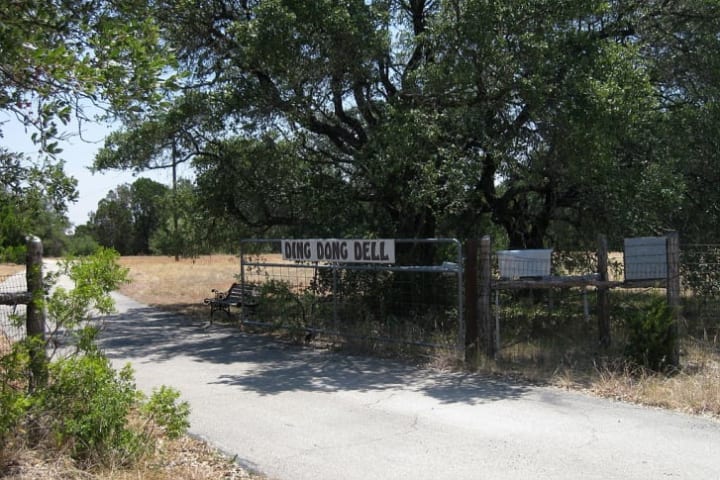
Ding Dong, Texas. / Oyoyoy, Wikimedia Commons // CC BY-SA 3.0
Upon learning that the town of Ding Dong is located in Bell County, Texas, you might reasonably conclude that the two facts are related. But you’d be wrong. The community was named after its founders, the Bell family—but they’re unrelated to Governor Peter Hansborough Bell, in whose honor the county was named.
44. Utah // Mexican Hat
Visitors to Mexican Hat, Utah, never have to wonder how the community got its name. The answer is as plain as day: a 60-foot-wide, sombrero-shaped rock formation on the northeast side of town.
45. Vermont // Satans Kingdom
If New England town names are any indication, Satan’s been awfully busy. The prince of darkness evidently has franchises in Massachusetts, Connecticut, and Vermont—the latter of which was purportedly named by a resentful settler who "expected fertile, rolling acres and had received rocks and hills instead."
46. Virginia // Bumpass
It’s pronounced “bump-iss,” the locals will tell you—if they tell you anything at all. Many Bumpass residents have developed a no-talking-to-strangers policy. Maybe they're just tired of being the butt of every joke.
47. Washington // Twisp
Twisp, located in Washington’s Methow Valley, might be named after the sound a wasp makes.
48. West Virginia // Lick Fork
While Lick Fork, West Virginia, might sound like a place dedicated to eating every crumb of delicious food from your plate, it’s most likely named after some local mineral licks.
49. Wisconsin // Bosstown
There’s a story in Wisconsin about a man named William Henry Dosch. He was ill as a child, and got used to the attention he received. As an adult, this led to him being a very bossy man. He received the nickname Boss, and after he opened a store in town, the place adopted the name Bosstown.
50. Wyoming // Recluse
Recluse, Wyoming, is located in the northeast corner of the state. If you can believe it, it’s a pretty isolated little community—and according to The origins of unusual place-names, that’s exactly why it got its moniker: “Name chosen in the 1800s because the settlement was established so far from civilization.”




